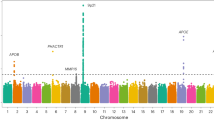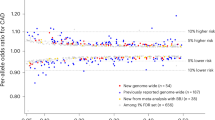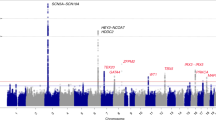Abstract
We constructed a high-density map of single-nucleotide polymorphisms (SNPs) present within a 31-kb region of human chromosome 13q31 that contains the human counterpart of the rabbit ITR gene, which encodes a rhodopsin-like G protein-coupled receptor associated with vascular remodeling. The elements of human ITR cDNA were distributed in 27,452 bp of genomic DNA; the nine exons ranged in size from 50 bp to 2271 bp, with an average size of 392 bp. We isolated a total of 22 SNPs from the ITR locus by systematically screening genomic DNA from 48 healthy Japanese individuals; three SNPs were present in the 5′ flanking region, two in coding elements, 12 in introns, and five in the 3′ untranslated region. By comparing our data with SNPs deposited in the dbSNP database in the National Center for Biotechnology Information, 19 of the 22 SNPs (86%) were considered to be novel. The map presented here should help in evaluating the role of human ITR in cardiovascular diseases, in other diseases mapped to this segment on chromosome 13q31, and in a variety of pharmacogenetic effects.
Similar content being viewed by others
Introduction
The ITR gene, encoding an intimal thickness-related receptor, was first identified in rabbits as a novel element whose expression was increased after catheterization of the aorta in a rabbit model of vascular injury (Tsukada et al. 2003). It encodes a novel membrane protein with a motif common to rhodopsin-like G protein-coupled receptors. The previous study also revealed that the cDNA of human ITR was 3531 bp long; its 1320-nt open reading frame predicted a 440-amino-acid protein that was produced predominantly in vascular smooth-muscle cells. The human gene was mapped to chromosome 13q31. Since ITR-deficient mice were found to be resistant to experimental thickening of the intima, we judged that the product of this gene might play an important role in the regulation of vascular remodeling.
In the study reported here we determined the genomic structure of the human ITR, and constructed a fine-scale map of 22 single-nucleotide polymorphisms (SNPs) that were detected at the ITR locus in a 96-chromosome sample of the Japanese population.
Subjects and methods
Blood samples were obtained with written informed consent from 48 healthy Japanese volunteers for this study, which was approved by the ethical committee of the RIKEN SNP Research Center. We obtained genomic sequences containing human ITR from the GenBank database (accession number AL359708.8) and then designed primer sets to amplify this gene in its entirety as well as up to 2 kb of genomic sequence upstream from the first exon and downstream from the last exon, only excluding most of the regions corresponding to human repetitive sequences predicted by the Repeat Masker Program (http://repeatmasker.genome.washington.edu/cgi-bin/RepeatMasker). Polymerase chain reaction (PCR) experiments were carried out using as templates 20-ng aliquots of DNA pooled from three individuals. Amplification of genomic DNA fragments by PCR, and DNA sequencing of the amplified fragments, were performed according to methods described previously (Iida et al. 2002). All variations detected by the PolyPhred computer program (Nickerson et al. 1997) were confirmed by sequencing both strands of each PCR product.
Results and discussion
The exon–intron organization of human ITR was defined by comparing the cDNA with genomic sequences. The nine exons of this gene were distributed in 27,452 bp of genomic DNA; exon sizes ranged from 50 bp to 2271 bp, with an average of 392 bp. The exon organization of human ITR and the locations of identified SNPs are illustrated schematically in Fig. 1. The first methionine codon of the open reading frame is located in exon 1; the termination codon and poly-A signal are in the last exon. Sequences at all exon–intron junctions adhered to the consensus for splicing junctions, including AG–GT (Table 1).
Genomic organization of human ITR and locations of single-nucleotide polymorphisms (SNPs) within the ITR locus. A total of 21 kilobases, excluding most genomic segments corresponding to repetitive sequences, were screened in the relevant 31-kb genomic region; the PCR amplicons are drawn as horizontal bars below the map. Exons and introns are represented respectively by rectangles and horizontal lines. The 22 SNPs identified in this study are indicated above the gene (designations correspond to those in the left-most column in Table 2)
We screened a total of 21,385 bp (69%) of the 31,000-bp genomic region containing human ITR, only excluding most of the regions containing repetitive sequences predicted by the Repeat Masker Program. We identified 22 SNPs within this locus: three in the 5′ flanking region, two in coding regions, 12 in introns, and five in the 3′ untranslated region (Fig. 1). Detailed information about each SNP is given in Table 2. The average density of SNPs in the 21,385-bp sequenced region was one in 972 bp. By comparing our data with SNPs deposited in the dbSNP database in NCBI, we were able to consider 19 of the 22 SNPs (86%) to be novel as of the end of November 2002. Two of the three SNPs deposited previously in the dbSNP had been derived from the Japanese SNP database (Haga et al. 2002). The frequencies of different substitutions were 41% for A/G, 36% for C/T, 9% for A/T, 9% for G/T, and 5% for C/G; transitions occurred 3.3 times more frequently than transversions. However, we found no non-synonymous substitutions in coding elements; moreover, the non-random distribution of SNPs across the entire ITR locus, i.e., only two of the 22 being in coding regions, suggests that human ITR has been under huge selection pressure to conserve sequence during evolution.
The 22 SNPs identified here should provide landmarks for evaluating the role of ITR in heart diseases, other conditions mapped to this local segment of chromosome 13q31, and a variety of pharmacogenetic effects.
References
Dunnen JT den, Antonarakis SE (2000) Mutation nomenclature extensions and suggestions to describe complex mutations: a discussion. Hum Mutat 15:7–12
Haga H, Yamada R, Ohnishi Y, Nakamura Y, Tanaka T (2002) Gene-based SNP discovery as part of the Japanese Millennium Genome Project: identification of 190 562 genetic variations in the human genome. J Hum Genet 47:605–610
Iida A, Saito S, Sekine A, Mishima C, Kitamura Y, Kondo K, Harigae S, Osawa S, Nakamura Y (2002) Catalog of 86 single-nucleotide polymorphisms (SNPs) in three uridine diphosphate glycosyltransferase genes: UGT2A1, UGT2B15, and UGT8. J Hum Genet 47:505–510
Nickerson DA, Tobe VO, Taylor SL (1997) PolyPhred: automating the detection and genotyping of single nucleotide substitutions using fluorescence-based resequencing. Nucleic Acids Res 25:2745–2751
Tsukada S, Iwai M, Nishiu J, Itoh M, Tomike H, Horiuchi M, Nakamura Y, and Tanaka T (2003) Inhibition of experimental intimal thickening in mice lacking a novel G-protein coupled receptor. Circulation 107:313–319
Author information
Authors and Affiliations
Corresponding author
Rights and permissions
About this article
Cite this article
Iida, A., Tanaka, T. & Nakamura, Y. High-density SNP map of human ITR, a gene associated with vascular remodeling. J Hum Genet 48, 170–172 (2003). https://doi.org/10.1007/s10038-003-0002-x
Received:
Accepted:
Published:
Issue Date:
DOI: https://doi.org/10.1007/s10038-003-0002-x




